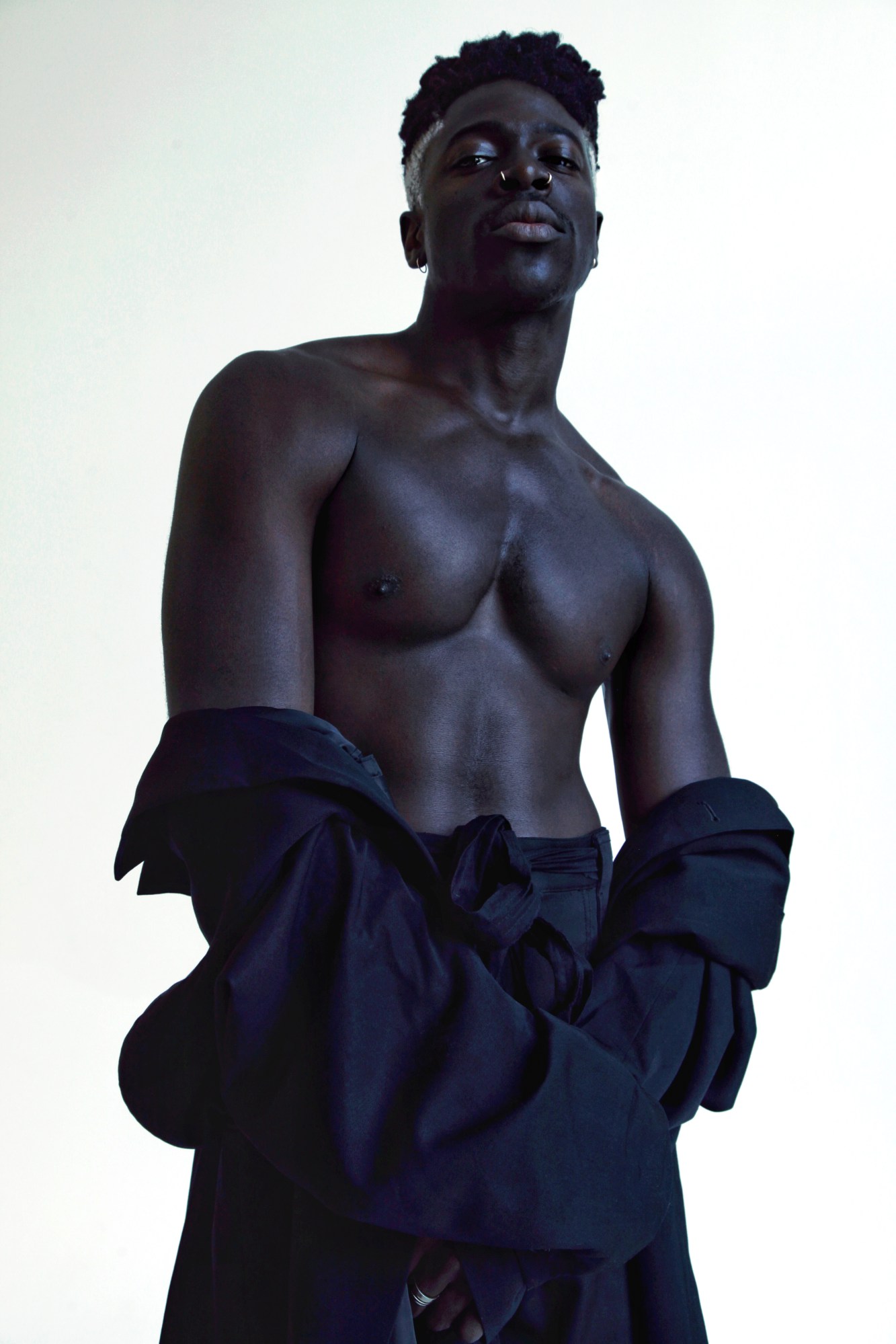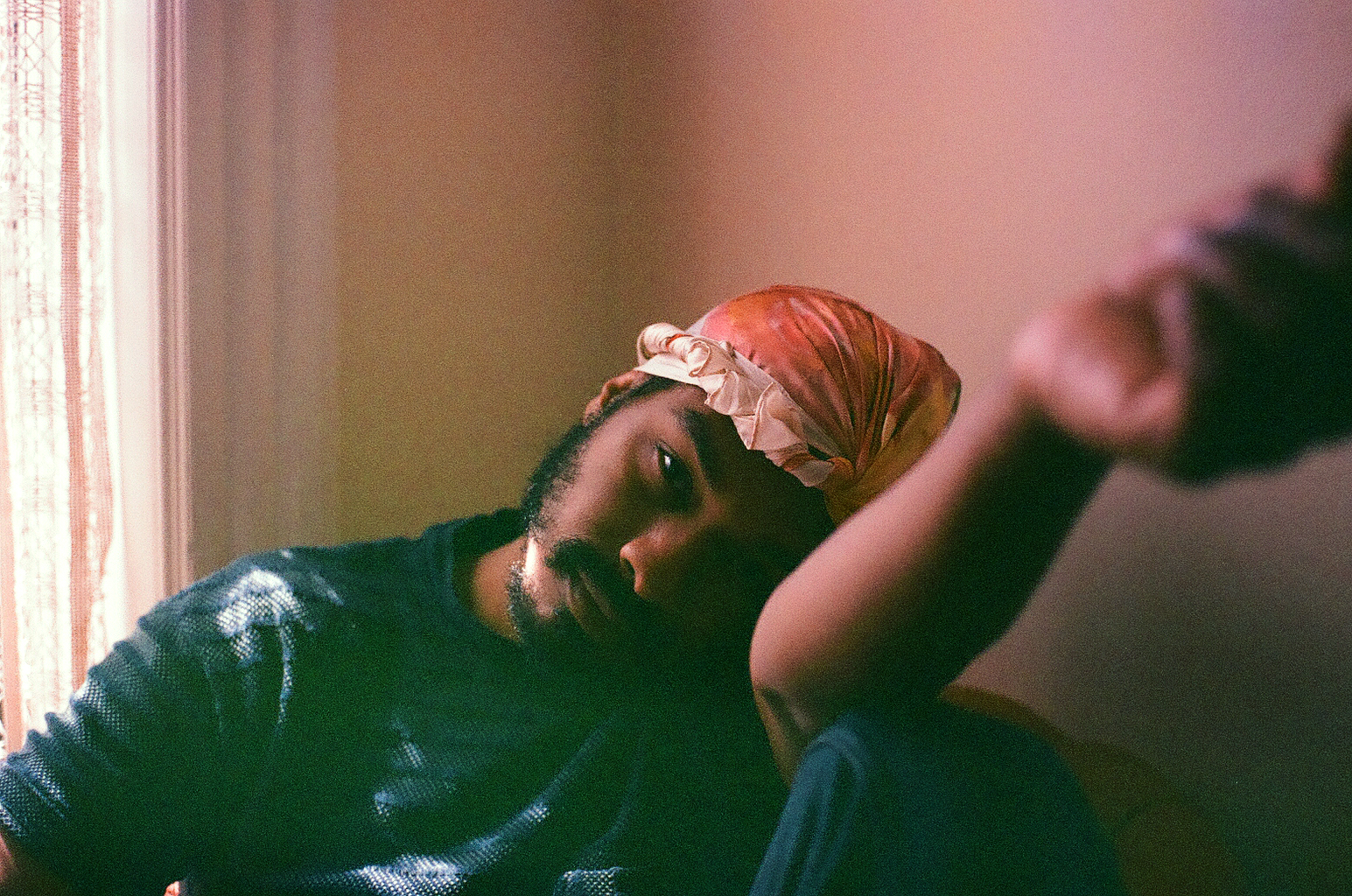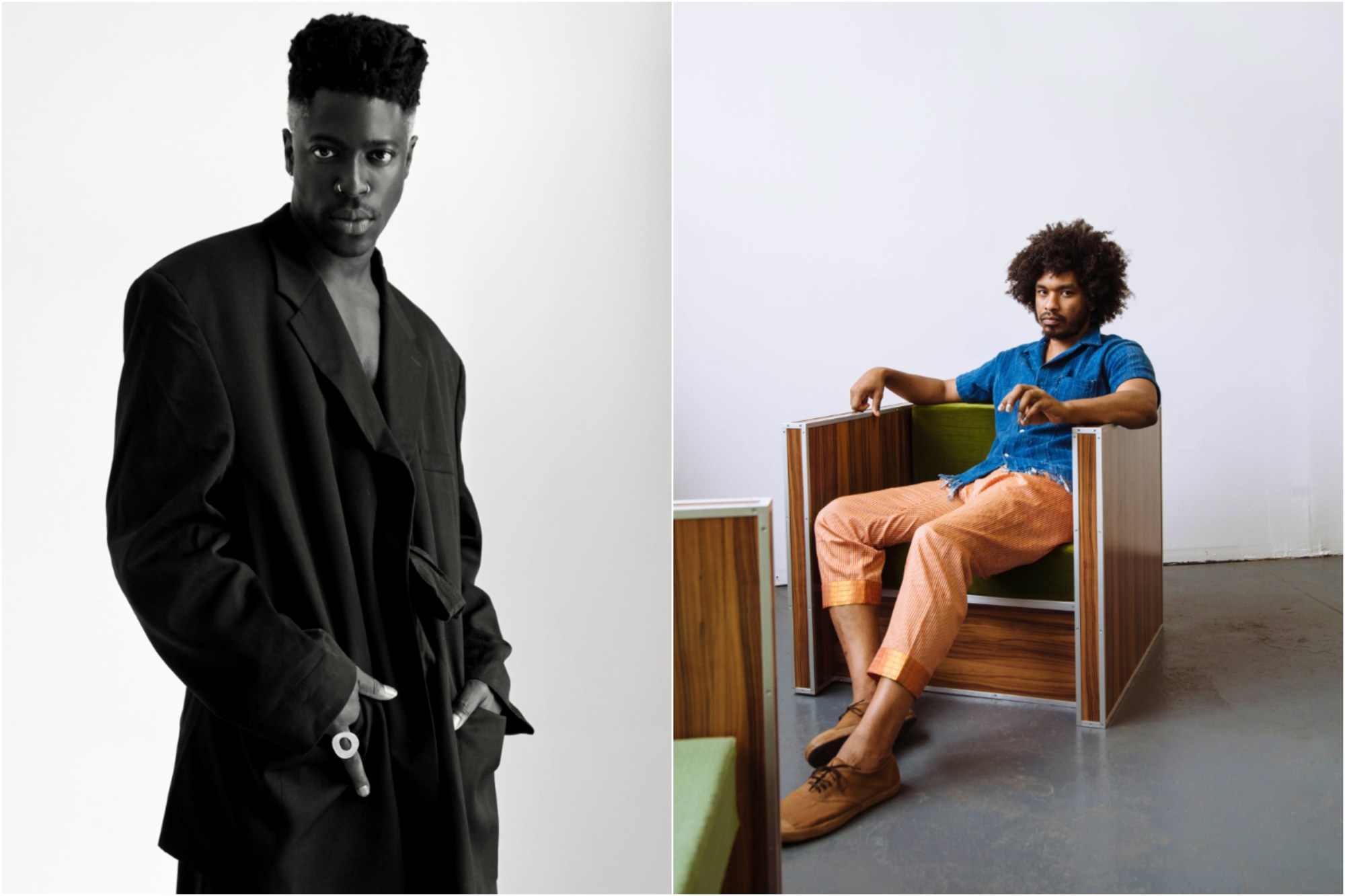When Moses Sumney first emerged out of the Los Angeles music scene in the early 2010s, he became known for his voice — an ethereal falsetto that both calmed your nerves and gave you goosebumps at the same time. It was the dazzling heart of Sumney’s soulful debut album, Aromanticism, and a transformative tool to explore love, loss and loneliness. Just last May, Sumney expanded his oeuvre with græ, a sprawling double album that proved the Ghanian-American singer knows no bounds. The ambitious record has been lauded as a sonic marvel that destroys binaries from within.
Sumney spent the last two years making græ, tirelessly pouring himself into the record but also the striking music videos that accompany its lead singles. While he’s always been very hands on in making visuals, “Cut Me” and “Virile” see Sumney both on-screen and in the director’s chair. The transition hasn’t been a difficult one. “Because I know the meaning of the song and I know the feeling that it evokes or that I was trying to evoke,” Sumney says, “it’s easy to create a separate world that feels connected or is a visual metaphor.”
Just before the release of his latest music video, “Me In 20 Years,” Sumney virtually sat down with filmmaker Terence Nance, creator of Random Acts of Flyness and contributor to Solange’s When I Get Home film, to discuss all things process, the trouble of mining pain and trauma to create art and the feeling of being consumed.
I’m inspired watching you direct and move into that space, expressing yourself with the level of mastery of your voice that’s on display. I see a real strong relationship between “Quarrel”, “Virile” and “Cut Me.” I think it’s continued in a way I didn’t expect on “Me In 20 Years.” I wonder how you’re visualizing these acts of love. It feels like there’s an act of devotion in each of the videos that is very clearly articulated. Was there a connection?
I think what’s interesting about filmmaking is it feels like everything is a love story in a way. I don’t necessarily seek to create with a love story in mind, but I think because of the way I’ve consumed film over the course of my lifetime, and the way film is expressed in modern culture, it’s like everything is a love story or turns into one. I think that affects the way we interpret work as well. It has been really interesting in my explorations of love, romance and loneliness to find different metaphors for that. I think you see a continuous throughline through those videos more than I do, but definitely with “Me In 20 Years” there’s this chasm, this hole that my character in the video is nurturing and loving, or maybe it’s representative of a love that once existed. I think in some ways it’s representative of self-love, but there is also the throughline of what it means to be loved as an Other, which “Quarrel” was certainly about. That was definitely reflective of what it means to be the Other and be romanticized or objectified in romance. And that carries through “Cut Me.”

I feel like I started to make the connection with “Virile.” There’s this Hortense Spillers essay called Mama’s Baby, Papa’s Maybe. It pretty famously articulates this difference between body and flesh, especially in the context of Black women, and how we identify as flesh, which is very different from the context of a body. To me, this is very clearly visualized in the meat market vibe [of the video] and then you align yourself with how meat is presented, aligning yourself with flesh and what is then available. That identification with flesh goes deep for me. Even in the lyrics you say something like, “All the boys are gatekeepers.” It’s interrogating how flesh and fleshiness is articulated with Black men. You roll with the “Virile” concept of masculinity, how reductive that is, but then you just start playing with it.
Yeah, that’s really interesting. I often feel like that, like flesh and merely flesh to be consumed by others. Both as an artist and as a Black man and as a Black man with my specific physicality, you can’t opt into it or opt out. As soon as you step outside you’re processed in this gaze, and whether or not you choose to participate in that gaze or not, it still is there and it still is reducing you. That actually ties back into what we were saying about romance — once you document that on film it then also becomes romantic.
And even though there is a brutality to “Virile” and to “Quarrel,” it’s still rather romantic. The ladybugs in “Virile” were so important to introduce because of how beautiful we think they are culturally. And then to see these beautiful creatures enact a violence, I felt like it was a good metaphor for the violence of being beheld and the violence of being consumed, even if you’re being consumed because people think you’re beautiful.
I read so much intentionality. It’s direct, but I do think that there is an interiority to the type of experience that you’re talking about, being consumed by people’s gaze. It’s not an accessible thing.
It’s not a universal feeling, which I forget sometimes. Do you feel that way? I wonder if you feel that way as a Black person and as a man, but as someone who’s a filmmaker and is often behind the camera. I wonder what you feel about the gaze and also being gazed upon.
In my conscious mind there’s like seven people whose opinion of me has a very strong effect on my day to day. So, that concept of feeling like there’s an effect by somebody’s framing of me, it feels limited to very few people. But I do get into moments of self-consciousness when I’m seen in a “public facing way,” but my conscious experience of that is like an echo chamber. It doesn’t feel all that precarious in any kind of way, but I think that’s probably because of some of the anonymity that I enjoy, being somebody who isn’t always in their work.
It’s interesting hearing you say that because in watching Random Acts of Flyness, I was intrigued and initially surprised to see you in it and in the capacity that you were. That felt very intentional and it’s very meta.
Yeah, I mean it’s very much fictional. It’s not me. It’s an invented thing that obviously has parallels, but is flattened for purposes of telling a story that isn’t my story. I don’t experience a fallout from it or anything akin to consumption of me in that way. I also think that there’s some part of it that isn’t romantic… There’s this dynamic, especially with “Cut Me” and “Me In 20 Years” of how a wound evolves. You said something in the lyrics about only feeling alive in a masochistic way, when causing pain is experienced.
When I’m weary/ and so worn out/ when my mind is clouded/ and filled with doubt/ that’s when I feel/ the most alive/ masochistic kisses/ are how I thrive.

I think that calling out of pain is evidence of life or discomfort. Like okay good, I’m alive. That kind of cannibalism is inherent in making art in a way, using all of your pain as an expressive thing. I saw myself in it in a way that kind of woke me up. I always constantly think about the sustainability in that — mining the pain and using the pain to check if your pulse is still going. It was so ecstatic how you visualized it. Even when you’ve got your therapy, your music and your things to manage it, it’s still this process of marshaling the wound, the sickness, the trauma. I was wondering how you come to visualize that and what your relationship is to it?
Well, I wrote that song when I was making Aromanticism, but it was just too bright, too happy sounding. I cut it, but I knew that I wanted to make it work for the second album. I just felt so embarrassed by it because it was so happy sounding and it was calling back to this mo-town or old soul era of music and it has this blues structure. For me, there wasn’t enough discomfort in the music itself. I wasn’t hearing enough pain in the music to be satisfied and my first record was all about pain, like when you bleed on the page, bleed on the paper, bleed on the Logic session. I was like, “The only way that I can make a song that has a sprightly step is to sing quite literally about pain, throw a wink and a nod at masochism and the tendency of the artist to want to feel hurt, or to mine one’s own hurt in order to feel like one has achieved something.” There has to be a real struggle.
The reason I directed [the music video for] that song is because I had the idea quite early. I knew it had to be a hospital. I knew there had to be an ambulance and I had to be both inside the ambulance as a victim, and riding the ambulance as a triumphant overcomer who is also exploiting his own pain and trauma. The visual very much came from the process of writing the song and feeling like, “Damn we love pain, we love to feel hurt.”
I sometimes think about the concept of the physical wound and the scar. Just as a physical thing, it’s the perfect illustration of what tragedy is. It takes less than a second to be cut, but it takes weeks for it to heal. And theoretically, there’s never total restoration to the previous state of health. The harm, the cut, the fissure or the break only takes a moment to execute, and not that much energy, but the process of healing takes so much more. It’s one of those things early in my life that was the design flaw of existence, you know? But in my present understanding of it, it’s more about creating an environment by which sentient beings can behave and have a concept of consequences. If the healing only took the same amount of energy as the wounding, if it was balanced, then there would be a lot more wounding happening. I mean, maybe that’s not true, but…
I think that’s very true. I think what we value sets the wound or how much it would take to make it go away. But I think you’re right in how it affects others, because we would enact hurt upon other people more if there was no evidence of an injury or even with evidence of an injury.
I was thinking about a conversation we had three years ago about Black humor. I just watched the first episode of your show and everybody dies in the first skit [called “Everybody Dies“]. There’s dark humor which I love and I absolutely adore, dark twisted humor. I’m deeply enjoying I May Destroy You because of how fucked up it is. I’m thinking about the lineage of Black humor and how Black people are capable of just mining their own historical or generational trauma and are so funny about it. When “Cut Me” had just come out it was the beginning of Covid and people were starting to realize that Black and brown people were most affected by it. Thinking about the way the hospital system treats Black people, it felt like a very challenging time for a music video in the back of an ambulance. I was like, “Should I not put this video out?” And then I was like, “No this video is hilarious.” Death is really funny in a lot of ways and it’s really fucked up.
I think you’re right. A big tool for survival is pain gets turned into laughter or melody is turned into scales. We take painful shit and make it funny, but we take funny shit and make it painful too because it doesn’t sit right if it’s too binary, too clean. It needs some distortion. That’s where we all live. Instead of having an accurate portrait of what’s going on in our psyche, it has to have that precarity.
Yes, in order to have an accurate painting of what’s going on in our psyche that precarity and that tension has to be present because it is ever present for us — psychically ever present.
